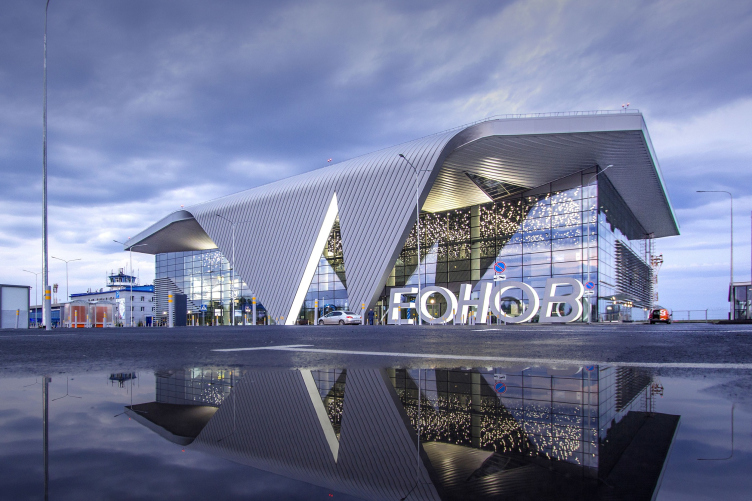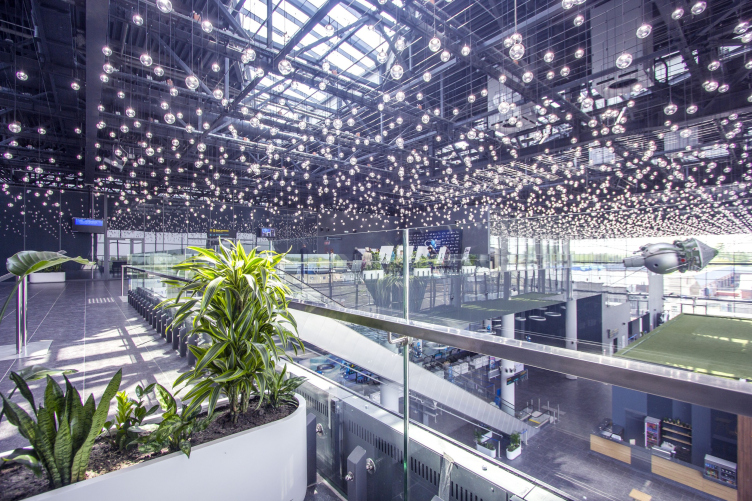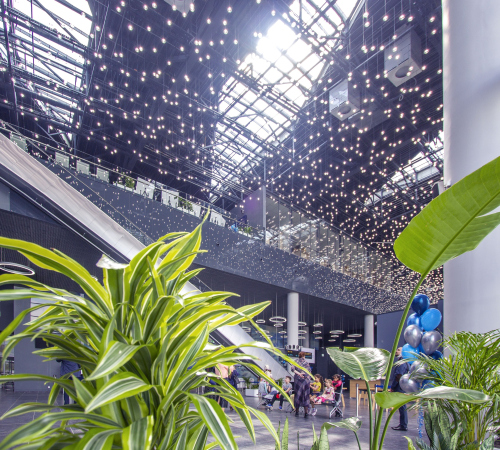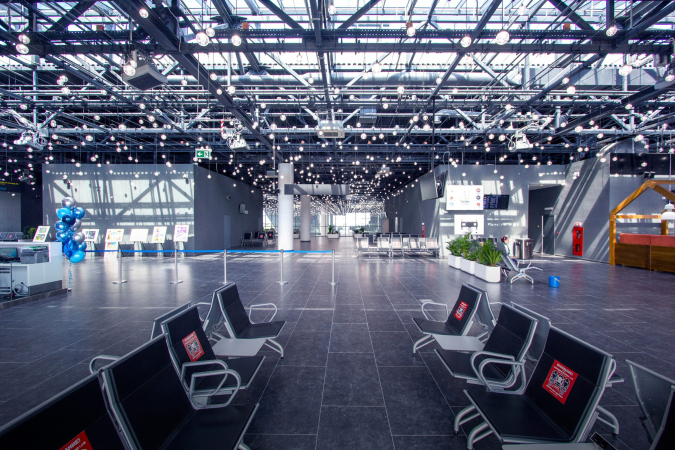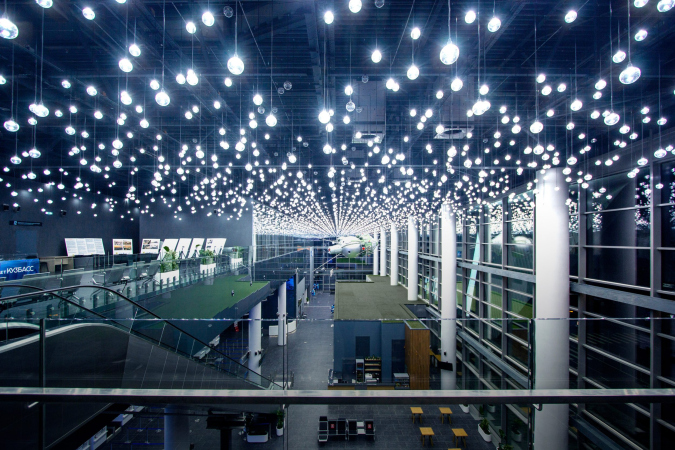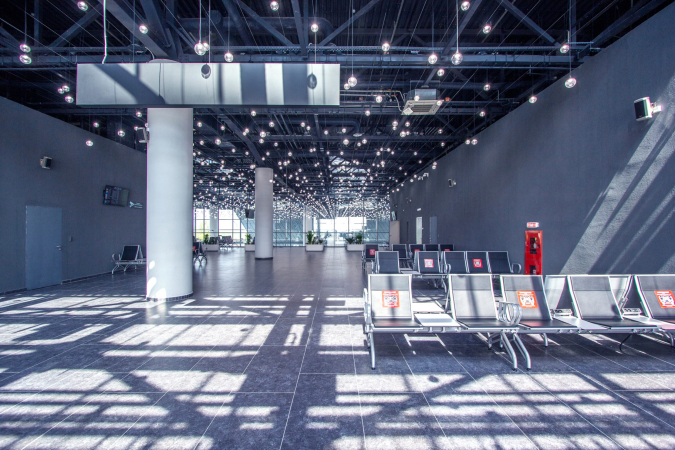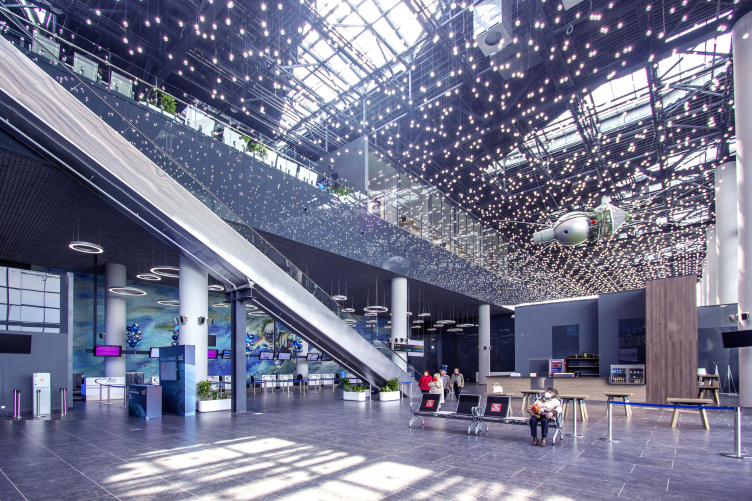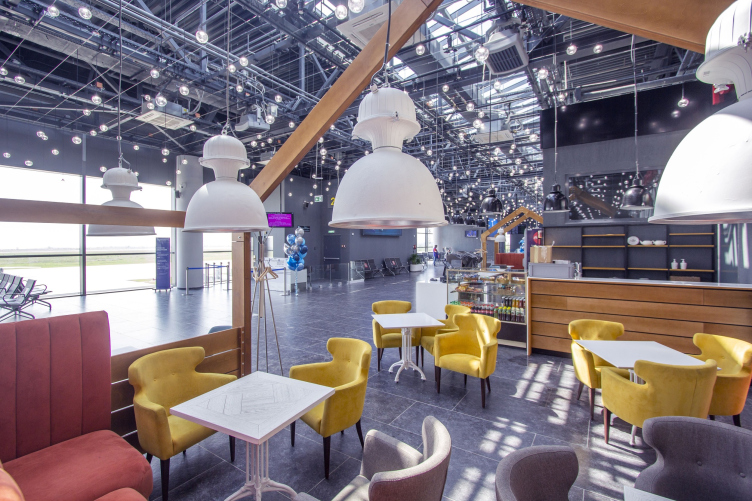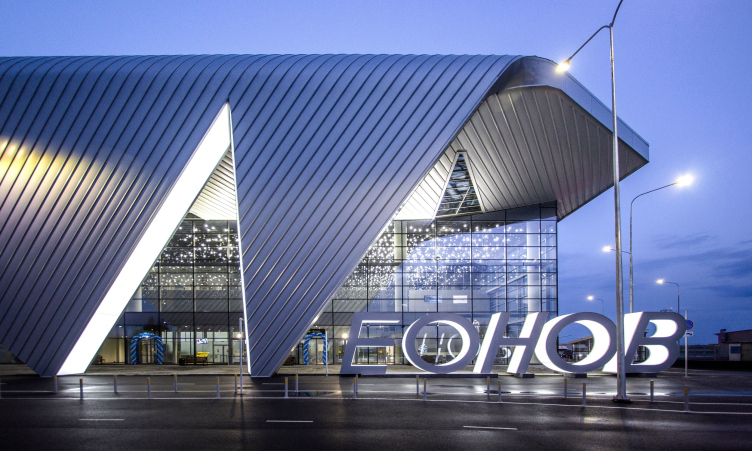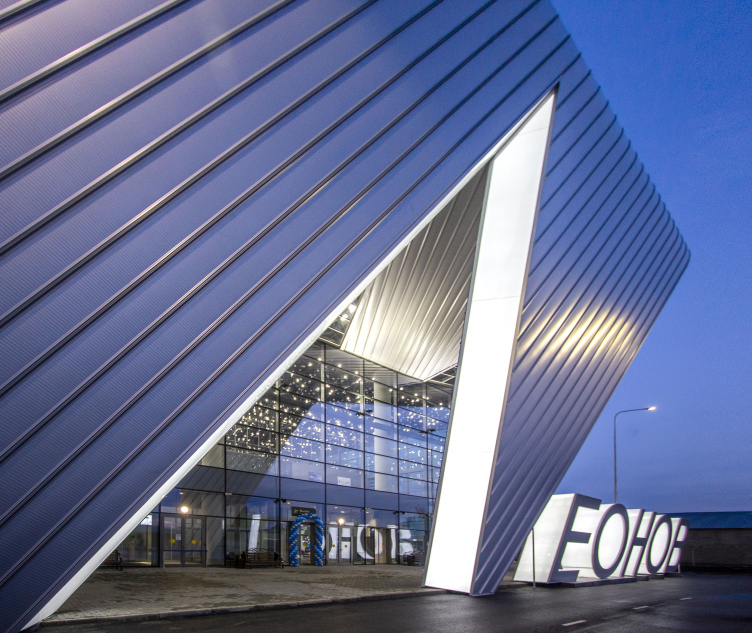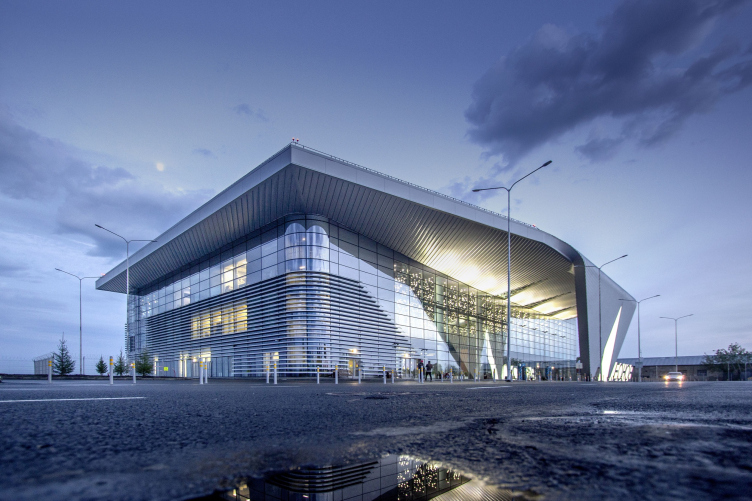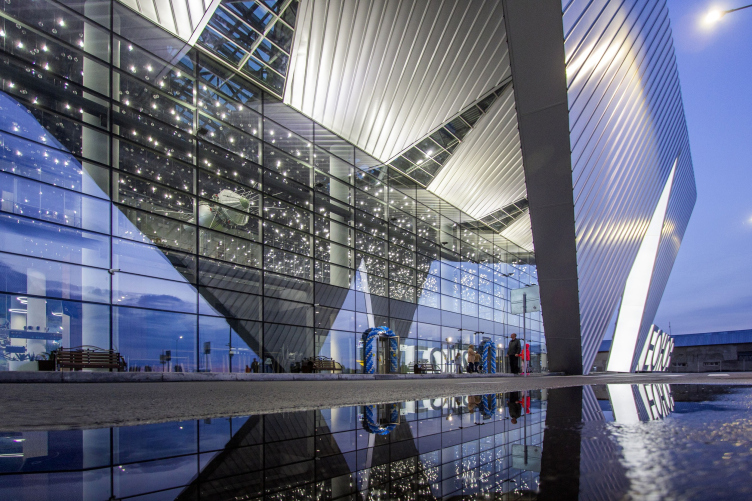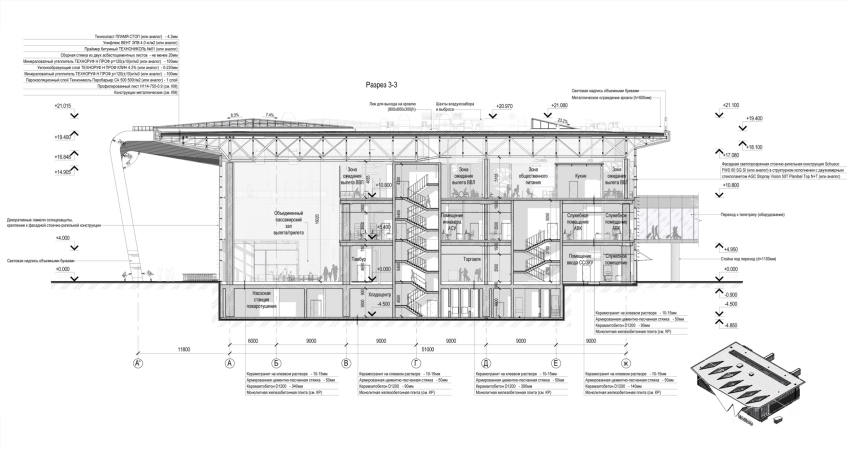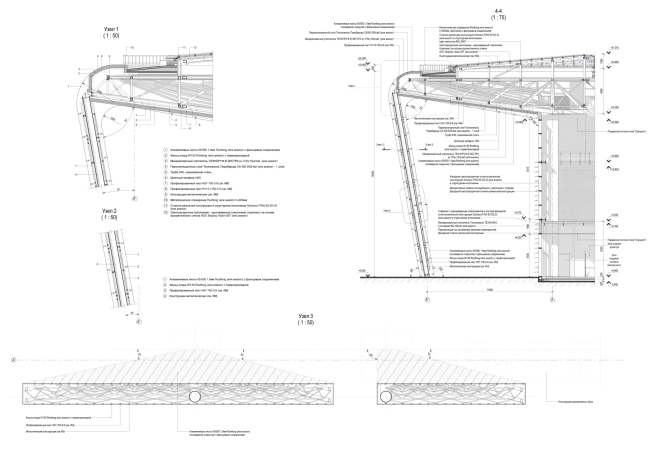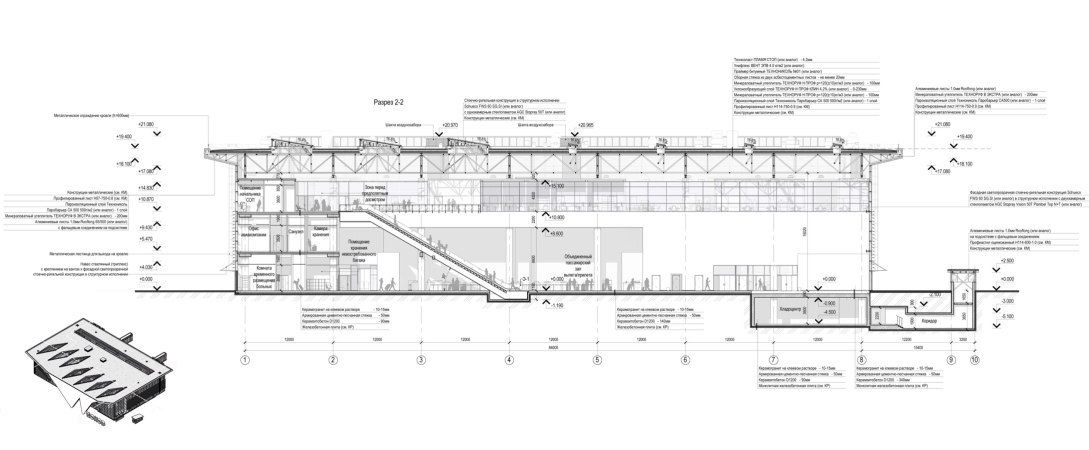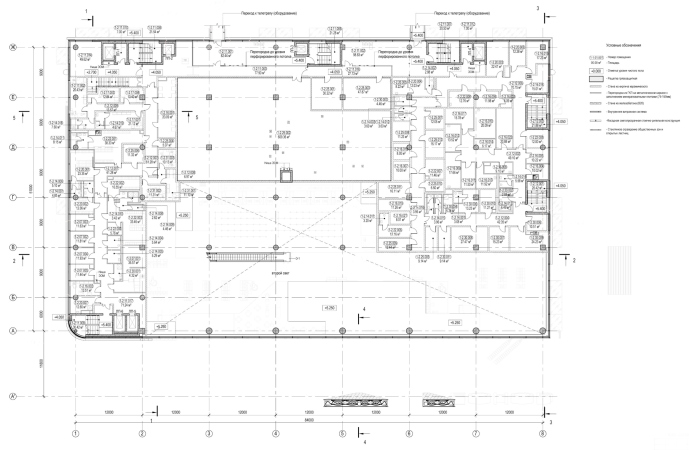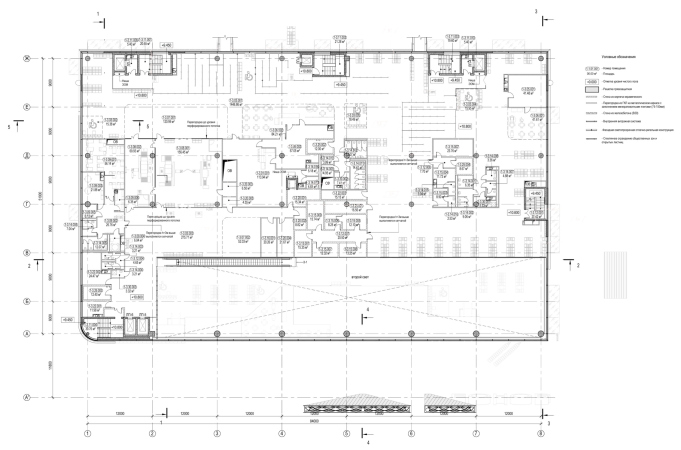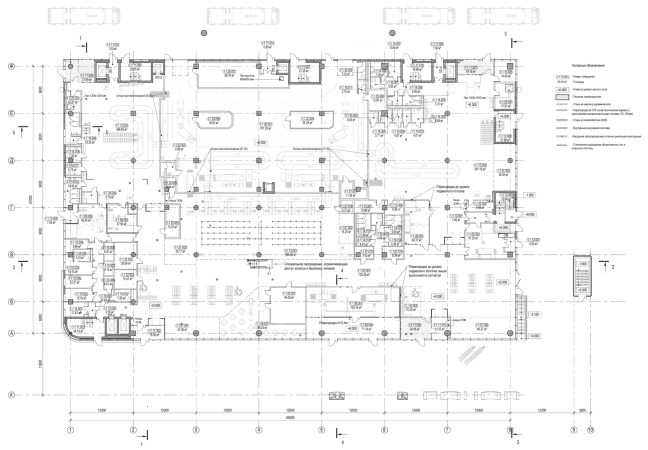The passenger terminal at the Kemerovo Airport
Copyright: Photograph © Andrey Asadov / provided by AB ASADOV
The construction of the new terminal became a part of the active city development for the 300th anniversary of the coal mining region of Kuzbass (in case you didn’t know, Kemerovo is its capital). There is a large sports cluster being built in the city; there will also be an exhibition and museum center. In 2019, in the place of the ill-fated shopping mall “Zimnyaya Vishnya, the city opened a memorial “Park of Angels”, built by the project developer and designed by the American landscape architect John Weidman.
For AB ASADOV, the Kemerovo terminal became already the third airport built by their concept (in 2017, “Bolshoe Savino” was built in the city of Perm, in 2019 “Gagarin” in Saratov), and, counting largely, the sixteenth airport building, to whose design they contributed. Designing airports became to a certain extent a specialty of this Moscow-based architectural company – the statement that the architects made at the recent ArchMoscow festival was dedicated to airports, and one could clearly see that the Asadov projects were evenly distributed across the country. The company’s considerable experience allows it to make precise calculations.
We love designing airports. On the one hand, they are quite pragmatic: the layouts are quite rigidly predetermined by function and, on the whole, an airport is an airport. On the other hand, each airport is a gateway to the city, its task is to broadcast the image of a place, and these projects are not just about function, but also about meanings that need to be captured and counted. You need to reveal the theme in the image of a building so that it is not just a terminal, but the face of a city or even a whole region. This is both a responsible and very interesting task.
We are grateful to the general designer, Spectrum, for the fruitful partnership and detailed elaboration of the concept. This is not the first time that we have collaborated with Spectrum: we worked together on the Gagarin Airport in Saratov and the airport in Perm. In the case of Kemerovo, our partners acted as full-fledged co-authors of a number of facade and interior solutions.
We are grateful to the general designer, Spectrum, for the fruitful partnership and detailed elaboration of the concept. This is not the first time that we have collaborated with Spectrum: we worked together on the Gagarin Airport in Saratov and the airport in Perm. In the case of Kemerovo, our partners acted as full-fledged co-authors of a number of facade and interior solutions.
So! The airport is the “city gate”, and it had to fit in with the ambitious program of its development. Some extra obligations were imposed by the very name of the airport – for a while now, we have had a trend of naming our airports after famous people, and a cosmonaut’s name is more than appropriate for that because cosmonauts start off as pilots, and their success stories are all about flying. The Kemerovo Airport is named after Alexey Leonov, the first person to ever walk into outer space; he is also known as an artist who depicted space, which became fertile ground for interior decoration, where an enlarged copy of one of Leonov’s paintings, a media museum of cosmonautics and a detailed model of the Voskhod-2 spacecraft, the one that carried Leoniv, on a 1:1 scale, appeared.
The passenger terminal at the Kemerovo Airport
Copyright: Photograph © Andrey Asadov / provided by AB ASADOV
The main “gem” of the airport is the starry sky inside. A myriad of diode lights are hooked up to control software that makes it possible to shape up any blinking mode you can possibly think of – the architects, for obvious reasons, have a soft spot for the one that’s calm and slightly out of sync – if necessary, the program will allow you to make an almost full-fledged light show (the installation and programming were done by the Turkish company Fiberli, and the architects are happy with the result).
The passenger terminal at the Kemerovo Airport
Copyright: Photograph © Andrey Asadov / provided by AB ASADOV
The cloud of lights is suspended from the ceiling on long thin wires – the ventilation units are not covered, but painted and situated high up, looking like some extra-terrestrial structure behind a group of pinpoint lights. This way, we are getting a “dispersed” version of a suspended ceiling, which does and does not mask at the same time – in the recent decades, this technique has been honed to perfection in the interiors of “loft” restaurants, and sometimes offices, but in the spacious hall of the airport terminal it produces quite a new effect, indeed a cosmic one. Few of us have seen the stars from outer space – we only occasionally read science fiction, where it is insistently said that they are very bright; in part, the impression can be compared to the night sky in August, suddenly abundant with stars, and then multiplied by eight in order help us to feel what Alexei Leonov felt when he stepped outside the space capsule. Now we can also get this feeling from the interior of the terminal, particularly at night when the lights shine in a relative darkness like the Milky Way in the pitch-black darkness of space.
The effect is further enhanced by the fact that the “star” lights are reflected in both outside windows, suggesting infinity, and in the stemalite interior panels that visually expand the space of the terminal. Yet another thing that contributes to creating a feeling of flying is a long escalator that elevates the travelers more than 10 meters – directly, without habitual zigzags – and dissects the space with a gliding arrow, in which one can see a metaphor for a takeoff, even if aviation instead of a space one.
It is amazing how small Vostok-2, modeled on a 1:1 scale, looks against the background of the escalator arrow.
The passenger terminal at the Kemerovo Airport
Copyright: Photograph © Andrey Asadov / provided by AB ASADOV
By the way, the idea of the airport museum in the airport is very convenient, especially if you have to wait for your flight with the kids. And the “starry sky”, much more with a spaceship, is a great continuation of it, as if the museum “stepped out into the interior” as the cosmonaut once did in space.
This way, even the little Orange tables in the cafe, if you let your imagination loose, may look a part of some intergalactic pitstop.
The passenger terminal at the Kemerovo Airport
Copyright: Photograph © Andrey Asadov / provided by AB ASADOV
On the whole, the Kemerovo airport rather accurately expressed the idea of “open space”, the only catch being that the sky is still inside, like an exhibit in a glass showcase. But then again, you can see it from the outside as well, particularly at night, so it does serve as an “exhibit” or as a continuation of the mini-museum inside of the airport.
The passenger terminal at the Kemerovo Airport
Copyright: Photograph © Andrey Asadov / provided by AB ASADOV
The shape of the building is also all about the idea of openness. The main facade is turned into a glass showcase, the roof is designed as a metallic slab (the coating material by Sevalcon Aluminium Blanc, montage by Riverclack) with a considerable thickness and diamond-shaped skylights – in a graceful curve, it goes down to the ground before the entrance, touching it at two points, forming the initial Λ in the large Λеонов inscription. This way, a deep canopy appears before the entrance, and a sort of a “gallery” of letters, filled with a lot of meaning. And, if we are to look at it from the gallery, the name appears twice: in reality and in reflection.
The passenger terminal at the Kemerovo Airport
Copyright: Photograph © Andrey Asadov / provided by AB ASADOV
The passenger terminal at the Kemerovo Airport
Copyright: Photograph © Andrey Asadov / provided by AB ASADOV
The passenger terminal at the Kemerovo Airport
Copyright: Photograph © Andrey Asadov / provided by AB ASADOV
One can argue whether the initial letter Λ will be easily readable – but the big initial letter is not read at once in gothic manuscripts either because it is made deliberately different. However, you need to admit that this is one of the rare examples when the heading is so gracefully inscribed into a building – in this instance, it is strikingly different from the habitual “slaps over the cornice” that the managing company adds when the architects are gone or at least turn away for a second. In this case, the name “came down from heaven to earth” and became a noticeable, not to say quintessential, element, turning into a sculpture and a part of the “wing” canopy, characteristic for Asadov airports.
The passenger terminal at the Kemerovo Airport
Copyright: Photograph © Andrey Asadov / provided by AB ASADOV
The passenger terminal at the Kemerovo Airport
Copyright: Photograph © Andrey Asadov / provided by AB ASADOV
On this photo, the sters, the reflections, and even the Vostok-2 spaceship are seen particularly vividly. The passenger terminal at the Kemerovo Airport
Copyright: Photograph © Andrey Asadov / provided by AB ASADOV
Partially – again, if you stir up your imagination a little bit – this sculpture can remind you of a fragment of a fallen space station, suspended mere feet above the ground by some sci-fi force field. You can also see here deconstruction, and a hint at something much larger, as if the airport is part of a larger whole. Because you can indeed perceive airports as fragments of the single aeronautics system.
The canopy and the roof “rest” upon glass, and the glass does look like a force screen – this thing still exists only in science fiction, but its image is very popular in the projects connected with modern cutting-edge technologies (take the Apple headquarters for example that surprised many people). Here this same feeling is recreated, which is very appropriate for an airport, much more a cosmic one. This effect is particularly noticeable at the northern corner, rounded, curvilinear, and covered by the stripes of horizontal lamellas.
The passenger terminal at the Kemerovo Airport
Copyright: Photograph © Andrey Asadov / provided by AB ASADOV
The entire picture looks mesmerizing: the glass of the facades, the glittering of the stars, the silvery metal – and, when set against the old utilitarian buildings of the Kemerovo airport, it looks indeed like a fragment of a space object, like in the “Roadside Picnic” model.
All this considering the fact that the terminal is comparatively small – about 11,000 square meters. To compare, the new Terminal B in Moscow’s Sheremetyevo, just like the new terminal in St. Petersburg’s Pulkovo, is 10 times as big; “New Savino” in Perm (also designed by AB Asadov) – you can even see a similar wing in it, similar rounding and lamellas – is 29,000 square meters. In addition to the fact that the terminal is not very large and was built in record-breaking time, it is also designed rather cost-efficiently with all of the effects remaining in place. Specifically, it was possible to save money on the false ceiling – the light bulbs helped, stemalite in the interiors also made it possible to create a wide spectacular space at not too high costs. This is why the building has just one rounded corner – however, it would probably be more correct to speak of a reasonable balance of costs, the speed of implementation and the effect of outer space, which was eventually achieved.




